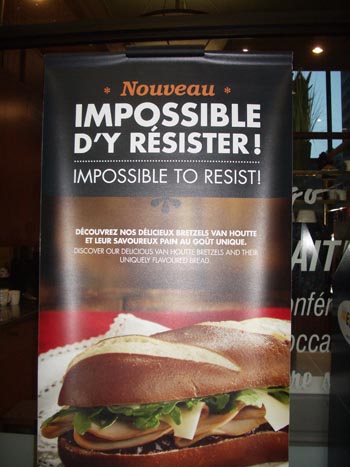In Part 1 of this blog post, we saw that the most common use of the French pronoun y is to refer to a a physical place or location. A typical translation would be “here” or “there.” Here is an example from a website:
Bienvenue sur notre site web. Vous y trouverez les réponses à toutes vos questions sur nos produits et services.
(Welcome to our website. Here you’ll find the answers to all the questions about our products and services.)
The “y” refers of course to “site web.” Notice that the “y” is inserted between the pronoun (vous) and the verb (trouverez).
This stuff is quite straightforward and should not be difficult to use. Now let’s look at some creative and more idiomatic uses where the role of “y” can be quite vague. In most cases, there is an allusion to something that was done or is to be done. In other cases, it’s just an idiomatic expression with no clear meaning for the “y.”
Let’s start with two examples that are typical of advertising language.
1. Impossible d’y résister (Impossible to resist)
The advertising poster (Fig. 1) of a café says “Impossible d’y resister.” What does the “y” refer to? Here, of course, it is referring to the food item in the photograph. The reader has to make the connection.
2. Ça fait longtemps que vous y pensez. (You’ve been thinking about it for a while)
In this picture (Fig. 2), there is no clear reference for “y.” Again, the reader must make the connection between the rest of the ad and the pronoun. In this particular case, the reference is to buying a new pair of eyeglasses. Note in passing the use of that other awesome pronoun “ça” in the very common construction “ça fait.”
3. Ça y est !
I’ve devoted an entire blog post this very common idiom. The basic meaning is “it’s done” “that’s it” or “it’s over.” Often this expression is used with another one, as in:
Ça y est ? C’est fini? (All done? Are you finished?)
Ça y est ! Il ne veut plus me parler. (That’s it. He doesn’t want to speak to me anymore.)
Est-ce que ç’a y été? (Did it go well?)
4. Allez-y, vas-y, allons-y
I’ve also devoted a blog post to this expression. This generally means “go ahead”, “go for it, you can do it, after you” or “let’s go.” Here it’s used in a typical dialog:
– Est-ce que je peux ? (May I?)
– Bien sûr. Allez-y ! (Of course, go ahead.)
5. Y compris
At the end of a list or when referring to a group, you would use “y compris” to mean “including” as in:
Tout le monde était d’accord, y compris mon père. (Eerybody agreed, including my dad.)
6. Y comprendre
This is mostly used in the negative form to mean “not understand a thing”
Je n’y comprends rien. (I don’t understand a thing.)
C’est à n’y rien comprendre. (It’s beyond me.)
C’est difficile d’y comprendre quoi que ce soit. (It’s hard to understand anything here.)
7. N’y pouvoir rien
This is usually means “can’t do anything” about something at hand.
Désolé, je n’y peux rien. (I’m sorry. I can’t do anything.)
On n’y peut rien. (There’s nothing we can do.)
8. Y voir
When used with the verb voir, y can sometimes be rather quite specific or rather vague. Here are some examples:
L’accident de voiture, faut-il y voir la main de Dieu? (Did God have a hand in this car accident?)
Vos droits, il faut y voir. (You have to look out for your rights.)
Je n’y vois pas d’inconvénient. (I don’t see a problem in this matter.)
On va essayer d’y voir plus clair. (We’ll try to get to the heart of this.)
9. Y faire
This usually means “to matter, to count.” Here is an example taken from a recent newspaper article.
La surpopulation ou les installations vétustes n’y feront rien. Trois des quatre projets de centre de détention dans les cartons du gouvernement Marois resteront en plan pour au moins deux ou trois ans encore.
Overcrowding and outdated facilities don’t matter. Three of the four projected detention centers in the plans of the Marois government will be postponed for two or three years.
10. S’y faire
This means “to get accustomed to”, as in:
Les prix augmentent tout le temps; il faut s’y faire. (Prices are going up all the time; you have to get used to it.)
11. S’y connaître
This is usually translated as “to be know a lot about.”
Elle s’y connaît en droit du travail. (She really knows a lot about labor law.)
Je ne m’y connais pas en informatique. (I don’t know much about computers.)
12. S’y prendre
This is roughly translated as “to undertake” or “to go about doing something.”
Comment faut-il s’y prendre pour trouver du travail ? (How does one go about finding work?)
Il s’y est pris très mal. (He went about it the wrong way.)
13. S’y mettre
This usually means “to start” or “to begin.”
Pour bien apprendre un instrument, il faut s’y mettre tôt. (To learn to play an instrument well, you have to start early.)
14. S’y méprendre
This is a rather literary idiom meaning “to be mistaken.”
Ils se ressemblent tellement, c’est à s’y méprendre. (The two resemble each other so much that it’s easy to mix them up.)
15. Y croire
This means “to believe it,”
Je n’arrive pas à y croire. (I can’t believe it.)
16. Il y va de…
This is a very formal way of saying that “something is at stake.” Here is an example:
Il y va de notre honneur (Our honor is at stake.)
Conclusion: adding subtlety with French pronouns
Like the other members of that quartet of awesome French pronouns (y, en, ça, on), y has depth. As I have demonstrated, there are the basic uses that everyone knows. And then there is a whole range of subtle uses where fine nuances of meaning can be conveyed if you know how to use this pronoun well.
Pay attention when listening and you will hear it used very often, especially with the idioms “allez-y”, “il y a” and “ça y est.” Once you have these uses under your belt, consider trying the more sophisticated uses that I’ve outlined here.
Related Posts
1.How To Use The Awesome French Pronoun “ça”
2. French Conversation – How To Use The Awesome Pronoun ON
Stanley Aléong is a polyglot, author, musician and language coach in French, English and Spanish. He likes to share his passion for languages and believes that anybody can learn to speak a foreign language well with the right methods and tools. He has also invented a cool visual learning tool called the Language Wall Chart Calendar that is based on his own learning experience. Reach him at info@langcal.com.



Could the second example also be phrased “ça fait longtemps que vous en pensez”? Why or why not? I ask because the example reminds me of constructions like “Qu’en pensez-vous ?”, which express a similar idea of “you think (about it).”
Thanks for the nice article.
You should not use “ça fait longtemps que vous en pensez?” because “penser de” means “to have an opinion about” not “to think of” which would be “penser à.” I’ve written a blog entry about this.